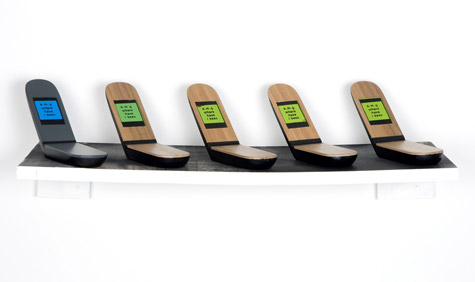
DISTRESS SIGNAL ONE Fredo Conde’s wooden sculptures of cell phones are part of “Boston Does Boston III.” |
Proof Gallery's third annual round-up of local talent, "Boston Does Boston III," invites five artists to invite one other artist each to join them in the show that creates a crowd-sourced snapshot of the city's art scene. This year's edition feels like dispatches from dissolute, dumb-ass-but-still-glam Great Recession America. "Cheap and beautiful seem like a good combination right now," writes Kimberly Hennessy (Arlington).
Hennessy has constructed an installation of bright pink and blue ribbons and paper trophies and self-portrait baseball cards that question the value of (art-world) success. Jess Wheelock (Cambridge) offers a puppet-animation video in which, as if in a dream, Dale Carnegie speaks to her from his earnest Depression-era book How To Win Friends & Influence People. Carnegie's technique: listen to whatever people want to say; tell them whatever they want to hear.
Trap by Justin Kemp (Amherst) sticks teen-mag posters of the Jonas brothers on the wall and leaves an actual banana peel on the floor for you to slip on underneath. Fredo Conde (Boston) fashions wooden sculptures of cell phones, each screen saying, "o.m.g. where have i been." Sam McKinniss (Boston) makes offhand realist paintings based on photos of friends and lovers that include a wan man standing naked in a field.
Maria Pinsky and Carter Seddon (both Boston) offer a pile of white shirts and photos of a mountain of bags of discarded clothing, people roaming mall parking lots, and the ugly architecture of desks cluttered with banks of computers (apparently representing a "loan company on the verge of bankruptcy"). It's a portrait of our marketplaces as one soul-sucking feng shui black hole after another.
The artists are mostly finishing up or just out of grad school. Their work offers exciting promise more than payoff, but as you imagine how it might develop, you get a crystal-ball vision of the future Boston art scene.
Tokyo conceptual artist Taro Shinoda invites you to relax on a pair of beanbag chairs set upon a low platform to watch his 45-minute video "Lunar Reflections" at the Isabella Stewart Gardner Museum. The shots alternate between cityscape footage of Tokyo, Istanbul, Limerick, and Boston at night and a wall-filling shot of the moon, craters and all, slowly floating by.
The museum reports that during his 2007 residency, Shinoda "was inspired by the moonlight and the sense of calm that reigns in the Gardner Museum courtyard." So he fashioned a meditative experience that, he says, is about "all of us sharing the planet together. I look at the moon, and, a few hours later, you look at it in some different country."
At first, the large shots of the moon orbiting feel kind of amazing and luxurious. But the repetition of the moon followed by some city (wind turbine, plane coming in for landing, stream of traffic, Hyatt hotel sign, large flapping flag) soon becomes random and empty and tedious.
Perhaps I'm too impatient. After I'd watched three-quarters of the video, a guard asked, "Are you okay?" "I'm just trying to see the whole thing," I replied. "Okay," he said, "this is your right." (When a museum guard thinks the only way you would sit through the whole video is if you're incapacitated, there may be a problem with the art.)